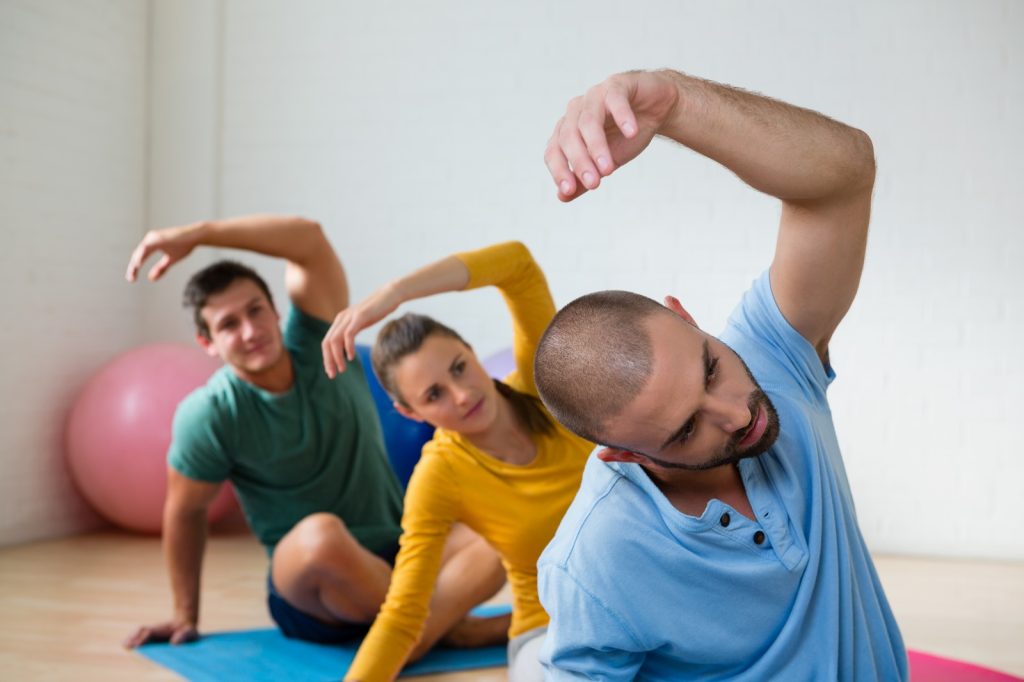Stretching
Stretching is an essential practice for maintaining and enhancing flexibility, preventing injuries, and promoting overall physical health. Whether you are an athlete, a fitness enthusiast, or someone looking to improve daily functional movements, incorporating stretching into your routine can offer significant benefits. Here’s a detailed guide on everything you need to know about stretching.
Why Stretching is Important?
Stretching involves lengthening muscles and tendons to improve flexibility, range of motion, and muscle tone. Regular stretching helps:
- Enhance Flexibility: Improved flexibility allows muscles and joints to move through their full range of motion, making daily activities easier and reducing the risk of injury.
- Improve Posture: Stretching helps correct muscle imbalances and alignment issues, leading to better posture and reduced chronic pain.
- Reduce Muscle Tension and Stress: Stretching promotes relaxation and reduces tension in muscles, which can help alleviate stress and improve overall mental well-being.
- Increase Blood Circulation: By increasing blood flow to muscles, stretching helps deliver essential nutrients and oxygen, aiding in muscle recovery and reducing soreness.
- Boost Athletic Performance: For athletes, stretching enhances performance by improving flexibility, agility, and coordination.

Types of Stretching
- Static Stretching:
- Description: Involves holding a stretch in a comfortable position for a period, typically 15-60 seconds.
- Benefits: Effective for improving flexibility and is best performed after a workout when muscles are warm.
- Example: Hamstring stretch – Sit on the floor with one leg extended and reach toward your toes.
- Dynamic Stretching:
- Description: Involves moving parts of your body through a full range of motion in a controlled manner.
- Benefits: Ideal as part of a warm-up routine to prepare muscles for physical activity.
- Example: Leg swings – Stand and swing one leg forward and backward.
- Ballistic Stretching:
- Description: Uses momentum to stretch muscles beyond their normal range of motion.
- Benefits: Can increase flexibility quickly but carries a higher risk of injury.
- Example: Bouncing toe touch – Reach for your toes with a bouncing motion.
- PNF Stretching (Proprioceptive Neuromuscular Facilitation):
- Description: Combines stretching and contracting muscles to increase flexibility.
- Benefits: Highly effective in improving range of motion and often used in physical therapy.
- Example: Partner hamstring stretch – Partner assists by pushing your leg while you resist.
- Active Stretching:
- Description: Uses the strength of agonist muscles to hold a stretch position.
- Benefits: Improves flexibility and muscle strength.
- Example: Standing quad stretch – Use your muscles to pull your foot towards your buttocks.
How to Stretch Properly
- Warm-Up First: Engage in 5-10 minutes of light aerobic activity like walking or jogging to warm up your muscles before stretching.
- Focus on Major Muscle Groups: Target the muscles you use most frequently and those that tend to be tight, such as the calves, hamstrings, hip flexors, quadriceps, shoulders, and neck.
- Hold Each Stretch: Maintain each stretch for at least 15-60 seconds without bouncing. A gentle pull is normal, but avoid pain.
- Breathe Deeply: Deep, steady breathing helps relax your muscles and increases the effectiveness of the stretch.
- Be Consistent: Stretch regularly, ideally at least 2-3 times a week, to maintain and improve your flexibility.
- Listen to Your Body: Stretch to the point of mild discomfort, not pain. Ease off if you feel any sharp or intense pain.
Sample Stretching Routine
- Neck Stretch: Sit or stand with your back straight. Tilt your head towards one shoulder and hold for 15-30 seconds. Repeat on the other side.
- Shoulder Stretch: Bring one arm across your chest and hold it with the opposite arm. Keep your shoulder down and gently pull. Hold for 15-30 seconds, then switch arms.
- Hamstring Stretch: Sit on the floor with one leg extended and the other bent. Reach towards the toes of the extended leg, keeping your back straight. Hold for 15-30 seconds, then switch legs.
- Quadriceps Stretch: Stand on one leg and pull your opposite foot towards your buttocks. Keep your knees together and stand tall. Hold for 15-30 seconds, then switch legs.
- Calf Stretch: Stand facing a wall with one foot forward and one foot back. Press your back heel into the ground and lean forward. Hold for 15-30 seconds, then switch legs.
- Back Stretch: Sit on the floor with your legs extended. Twist your torso to one side, placing your opposite arm across your knee. Hold for 15-30 seconds, then switch sides.
Stretching Tips and Safety
- Hydrate: Drink plenty of water to keep your muscles hydrated and flexible.
- Use Proper Technique: Incorrect stretching can lead to injuries. Follow proper techniques and consider consulting a professional if unsure.
- Avoid Overstretching: Do not force your body into painful positions. Stretch gradually and respect your limits.
- Combine with Strengthening: Pair stretching with strength exercises to maintain muscle balance and overall fitness.

Incorporating stretching into your daily routine can significantly enhance your flexibility, prevent injuries, and improve your overall well-being. Whether you are an athlete looking to boost performance or simply aiming to stay active and healthy, a consistent and well-rounded stretching regimen is key. Follow the guidelines above to ensure you stretch effectively and safely, making stretching a beneficial part of your lifestyle.
Contact Us
Feel free to contact Dr. Burhan to book a consultation and learn how a tailored stretching routine can benefit your flexibility and overall health. Dr. Burhan and his dedicated team provide personalized guidance to help you integrate effective stretching techniques into your daily life, whether you’re aiming to enhance athletic performance, prevent injuries, or improve posture. Reach out today to take the first step towards a healthier, more flexible you with expert advice and support.


